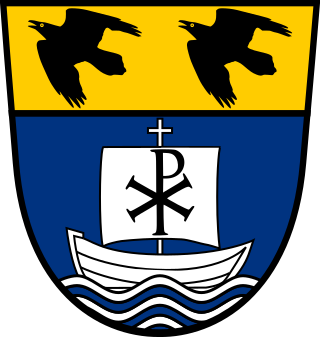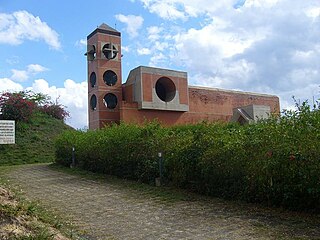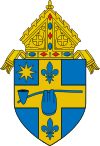
The Benedictines, officially the Order of Saint Benedict, are a monastic religious order of the Catholic Church following the Rule of Saint Benedict. They are also sometimes called the Black Monks, in reference to the colour of their religious habits. They were founded in 529 by Benedict of Nursia, a 6th-century monk who laid the foundations of Benedictine monasticism through the formulation of his Rule.

St Benet's Hall was a permanent private hall (PPH) of the University of Oxford, originally a Roman Catholic religious house of studies. It closed in 2022. The principal building was located at the northern end of St Giles' on its western side, close to the junction with Woodstock Road, Oxford.

Benedictine College is a private Benedictine liberal arts college in Atchison, Kansas, United States. It was established in 1971 by the merger of St. Benedict's College for men and Mount St. Scholastica College for women. It is located on bluffs overlooking the Missouri River, northwest of Kansas City, Missouri. Benedictine is one of a number of U.S. Benedictine colleges and is sponsored by St. Benedict's Abbey and Mount St. Scholastica Monastery. The abbey has a current population of 53 monks, while the Mount monastery numbers 147 community members. The college has built its core values around four "pillars" — Catholic, Benedictine, Liberal Arts, Residential — which support the Benedictine College mission to educate men and women in a community of faith and scholarship.

Saint Leo University is a private Roman Catholic liberal arts university in St. Leo, Florida. It was established in 1889. The university is associated with the Holy Name Monastery, a Benedictine convent, and Saint Leo Abbey, a Benedictine monastery. The university and the abbey are both named for Pope Leo the Great, bishop of Rome from 440 to 461. The name also honors Leo XIII, who was Pope at the time, and Leo Haid, then abbot of Maryhelp Abbey in North Carolina, now Belmont Abbey, who participated in founding the university and served as its first president.

San Beda University is a private Catholic coeducational basic and higher education institution run by the Order of Saint Benedict in San Miguel, Manila, Philippines. It was founded by the Benedictines in 1901. Its main campus which provides tertiary education is situated in Mendiola, San Miguel, Manila. It has a satellite campus that provides elementary and high school education in Taytay, Rizal.

Maurus (512–584) was the first disciple of Benedict of Nursia. He is mentioned in Gregory the Great's biography of the latter as the first oblate, offered to the monastery by his noble Roman parents as a young boy to be brought up in the monastic life.

Saint Meinrad Archabbey is a Catholic monastery in Spencer County, Indiana, US, was founded by monks from Einsiedeln Abbey in Switzerland on March 21, 1854, and is home to approximately 79 monks. The Saint Meinrad Seminary and School of Theology is also located on the premises.

Downside Abbey is a Benedictine monastery in England and the senior community of the English Benedictine Congregation. Until 2019, the community had close links with Downside School, for the education of children aged eleven to eighteen. Both the abbey and the school are at Stratton-on-the-Fosse, between Westfield and Shepton Mallet in Somerset, South West England. In 2020, the monastic community announced that it would move away from the present monastery and seek a new place to live. On 27 October 2021, the monastic community further announced that as part of their transition they would move in Spring of 2022 to the temporary accommodation of "Southgate House, in the grounds of Buckfast Abbey, Devon, where we will live as the Community of St Gregory the Great". As of 2020, the monastic community of Downside Abbey was home to fifteen monks.

Glenstal Abbey is a Roman Catholic Benedictine monastery of the Congregation of the Annunciation located in Murroe, County Limerick, Ireland. It is dedicated to Saint Joseph and Saint Columba. The current abbot of the monastery is Brendan Coffey.

Subiaco Abbey is an American Benedictine monastery located in the Arkansas River valley of Logan County, Arkansas, part of the Swiss-American Congregation of Benedictine monasteries. It is home to thirty-nine Benedictine monks. The abbey and the preparatory school it operates, Subiaco Academy, are major features of the town of Subiaco, Arkansas. It is named after the original Subiaco, Italy, where the first monastery founded by Saint Benedict was located.

St. Anselm's Abbey is a Benedictine Abbey located at 4501 South Dakota Avenue, N.E., in Washington, D.C. It operates the boys' middle and high school St. Anselm's Abbey School, which was ranked by the Washington Post as the most challenging in Washington, D.C., and as the most challenging private high school in the U.S.

The Abbey of Saint Mary and Saint Louis is an abbey of the Catholic English Benedictine Congregation (EBC) located in Creve Coeur, in St. Louis County, Missouri in the United States. The Abbey is an important presence in the spiritual life of the Archdiocese of St. Louis. The monks of the Abbey live their faith according to the Benedictine discipline of 'prayer and work', praying the Divine Office five times daily, celebrating daily Masses in English and Latin, and working in the two parishes under their pastoral care and in the Saint Louis Priory School, which the Abbey runs as an apostolate. The Abbey and its school sit on a 150-acre (0.61 km2) campus in west St. Louis County, in the city of Creve Coeur.
The Benedictine Sisters of St. Walburg Monastery is a Roman Catholic congregation of women. whose motherhouse, St. Walburg Monastery, is located at Villa Madonna, in Villa Hills, Kentucky. It was founded in 1859 by three sisters of the Benedictine congregation of Mount St. Benedict Monastery in Erie, Pennsylvania, who came to Covington to teach the German-speaking children of St. Joseph's parish. They became an independent congregation in 1867. Villa Madonna Academy, a private, Roman Catholic K-12 school is an integral part of the sisters' ministry in Kentucky. Besides operating the Academy, the sisters taught in parish schools and staffed St. John's Orphanage.

Ampleforth Abbey is a monastery of Benedictine monks a mile to the east of Ampleforth, North Yorkshire, England, part of the English Benedictine Congregation. It descends from the pre-Reformation community at Westminster Abbey through the last surviving monk from Westminster, Sigebert Buckley. As of 2023 the monastery has 46 monks.

San José Abbey, Güigüe, Venezuela, is a Benedictine abbey of the Congregation of Missionary Benedictines of Saint Ottilien. Currently located to the south of Lago de Valencia, the monastic community was originally established as a mission procure in Caracas following World War I. Caracas' expansion restrained the development of the abbey, and in the late 1980s the monks relocated to Güigüe. The community's superior is Fr Abbot José María Martínez Barrera.

Saint Anselm Abbey, located in Goffstown, New Hampshire, United States, is a Benedictine abbey composed of men living under the Rule of Saint Benedict within the Catholic Church. The abbey was founded in 1889 under the patronage of Saint Anselm of Canterbury, a Benedictine monk of Bec and former archbishop of Canterbury in England. The monks are involved in the operation of Saint Anselm College. The abbey is a member of the American-Cassinese Congregation of the Benedictine Confederation.
Saint Martin's University is a private Benedictine university in Lacey, Washington. It was founded in 1895 as an all-boys boarding school by monks of the Benedictine Order. Saint Martin's began offering college-level courses in 1900 and became a degree-granting institution in 1940. The college became coeducational in 1965. In 2005, it changed its name from Saint Martin's College to Saint Martin's University. It has a functioning Benedictine monastery on school grounds and some members of the monastic community also serve as professors.

Tokwon Abbey was a Benedictine monastery of the Congregation of Missionary Benedictines of Saint Ottilien, located near the town of Wonsan in what is now North Korea. Founded as a monastic mission in Seoul, the community transferred to Tokwon in the 1920s to take charge of the newly created Apostolic Vicariate of Wonsan. The persecution of Christians in North Korea since 1949 made any church activity in the abbacy impossible. However the Territorial Abbacy of Tokwon is formally still kept as one of the few remaining territorial abbeys within the Catholic Church.

Saint Maurus and Saint Placidus Abbey, Waegwan, Chilgok, North Gyeongsang, South Korea is a Benedictine monastery of the Congregation of Missionary Benedictines of Saint Ottilien. Established in 1952 by Korean monks who had survived the dissolution of the Territorial Abbey of Tokwon and Holy Cross Abbey in Yanji, the monastery is currently home to 131 monks. Fr Blasio Park is the current abbot.

Michael Lensing was a Benedictine monk and the fourth Abbot of Subiaco Abbey in Arkansas.




















